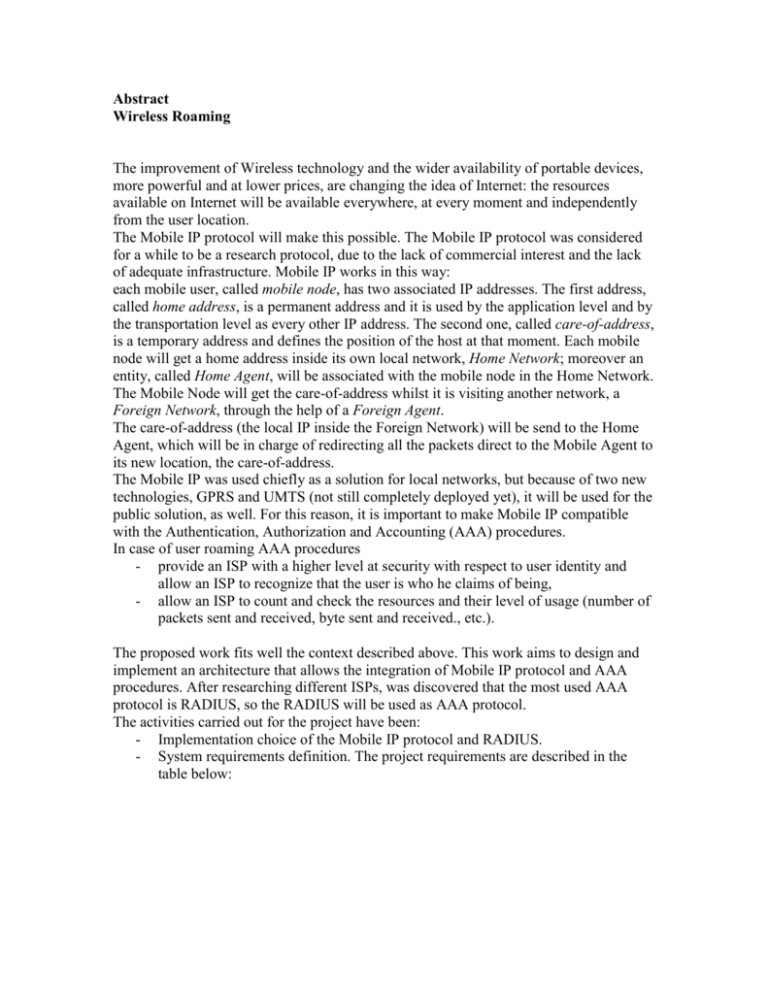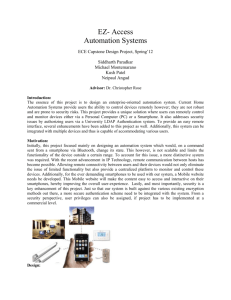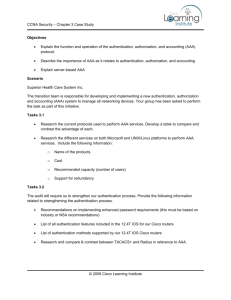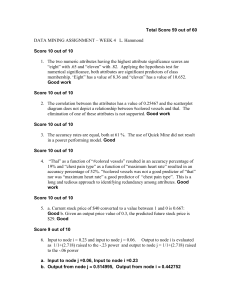Abstract Wireless Roaming The improvement of Wireless technology
advertisement

Abstract Wireless Roaming The improvement of Wireless technology and the wider availability of portable devices, more powerful and at lower prices, are changing the idea of Internet: the resources available on Internet will be available everywhere, at every moment and independently from the user location. The Mobile IP protocol will make this possible. The Mobile IP protocol was considered for a while to be a research protocol, due to the lack of commercial interest and the lack of adequate infrastructure. Mobile IP works in this way: each mobile user, called mobile node, has two associated IP addresses. The first address, called home address, is a permanent address and it is used by the application level and by the transportation level as every other IP address. The second one, called care-of-address, is a temporary address and defines the position of the host at that moment. Each mobile node will get a home address inside its own local network, Home Network; moreover an entity, called Home Agent, will be associated with the mobile node in the Home Network. The Mobile Node will get the care-of-address whilst it is visiting another network, a Foreign Network, through the help of a Foreign Agent. The care-of-address (the local IP inside the Foreign Network) will be send to the Home Agent, which will be in charge of redirecting all the packets direct to the Mobile Agent to its new location, the care-of-address. The Mobile IP was used chiefly as a solution for local networks, but because of two new technologies, GPRS and UMTS (not still completely deployed yet), it will be used for the public solution, as well. For this reason, it is important to make Mobile IP compatible with the Authentication, Authorization and Accounting (AAA) procedures. In case of user roaming AAA procedures - provide an ISP with a higher level at security with respect to user identity and allow an ISP to recognize that the user is who he claims of being, - allow an ISP to count and check the resources and their level of usage (number of packets sent and received, byte sent and received., etc.). The proposed work fits well the context described above. This work aims to design and implement an architecture that allows the integration of Mobile IP protocol and AAA procedures. After researching different ISPs, was discovered that the most used AAA protocol is RADIUS, so the RADIUS will be used as AAA protocol. The activities carried out for the project have been: - Implementation choice of the Mobile IP protocol and RADIUS. - System requirements definition. The project requirements are described in the table below: Software Authentication and Authorization Accounting - - - Requirements • Merit RADIUS Server • Dynamics HUT Mobile IP • The Mobile Node asks for the services in a Foreign ISP which; o Send the authentication request to the AAA server that manages the Home Network of the mobile node; o If the authentication of the mobile node fails, then the Mobile Node and Foreign Agent try the registration procedure again; o If the Mobile Node registration is denied, then the Mobile Node and the Foreign Agent try the authentication procedure again; o During a session some local authentications have to be realized. • If the Mobile Node goes back to the Home Network, than the standard authentication procedure will be followed. • Accounting Parameters: sent packets, received packets, sent byte, received bytes; • Accounting Start signal will be sent after the registration of the Mobile Node; • Accounting Stop will be sent only after the Mobile Node has left the Foreign Network; • Interim Accounting will be sent periodically inside a session. Designing of a RADIUS Mobility Interface (RMI), through which the communication between the Mobile IP protocol and the RADIUS protocol happens. During this phase there have been a lot of problems, as a new protocol has been developed. The Mobile IP and RADIUS characteristics have been taken into account, as well as, the temporization of the messages. Implementation of RMI, that has implicated an accurate analysis of the source code of selected Mobile IP. The interface has to interact with RADIUS and with Mobile IP. The interface implementation is independent from both RADIUS and Mobile IP, even if some changes of the Mobile IP code have been necessary (for instance the Foreign Agent functionalities). Configuration of the environment for the architecture AAA installation for the Mobile IP. Verification of the architecture performances through a set of tests, whose aim was project requirements analysis. The system has been developed and implemented in a laboratory environment, so it would be possible to provide a working demonstration. For further information, please mail to: Mauro Draoli <m.draoli@src.cnr.it> Paolo Pucciarini <paolo.pucciarini@convergere.com>





